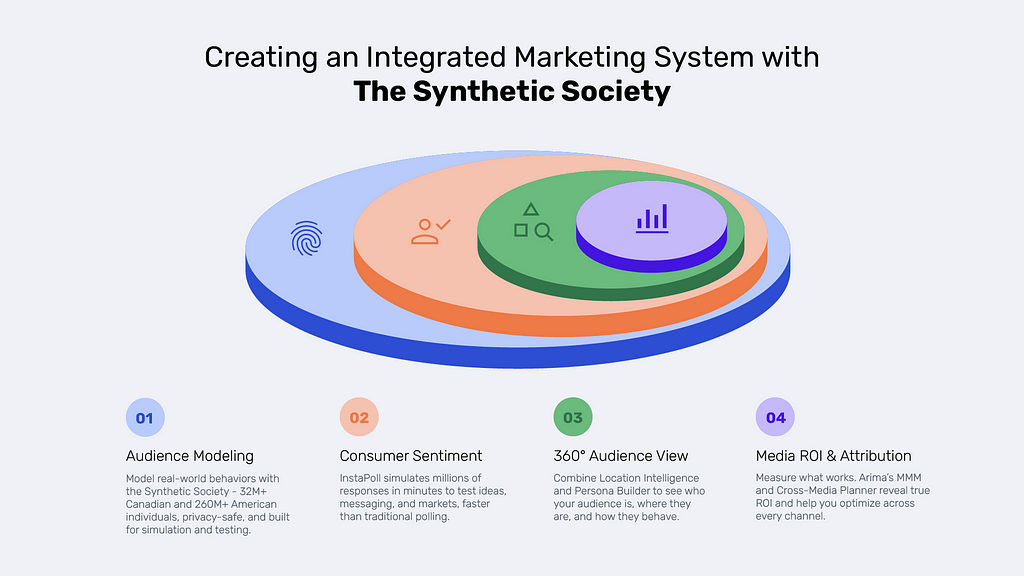Marketing mix modeling (MMM) is one of the most powerful tools marketers have to measure and optimize their spend. But even the best models are only as good as the data you feed them.
Arima has made significant progress in the field of synthetic data, opening up new ways to enhance the capabilities of Marketing Mix Modeling.
You might wonder: “If my MMM already uses my sales and media spend data, why would I need synthetic data?” It’s a good question. Synthetic data doesn’t replace your valuable first-party data, it enhances it. By filling in gaps, ensuring privacy compliance, and enabling more robust scenario testing, synthetic data strengthens your MMM.
Even if you have strong first-party data, synthetic data adds value in several ways:
- Completeness: Your first-party data describes your current customers, but says little about the rest of the market. Synthetic data helps you model audiences you haven’t reached yet.
- Granularity: It enriches your models with variables you might not collect, like income bands, household composition, or mobility patterns.
- Simulation and Forecasting: You can test “what-if” scenarios on realistic, privacy-safe populations without breaching user trust.
- Bias Correction: It helps counteract biases in your own data (for example, over-indexing on loyal customers or certain regions).
But what if you don’t have robust first-party data yet? In this case, synthetic data is even more valuable:
- Provides a Starting Point: Synthetic data can serve as your foundational dataset, giving you a realistic, representative population to model against when you lack your own customer data.
- Fills Critical Gaps: Many brands struggle with incomplete, sparse, or siloed data. Synthetic data supplies the variables you’re missing.
- Privacy-First from Day One: If you don’t yet have permissions or systems in place to collect granular personal data, synthetic data lets you build and test models safely and ethically.

In both cases, synthetic data makes your MMM smarter, broader in scope, and more future-proof , so you can make better decisions with or without perfect first-party data.
Better Forecasting with Population Data
Traditional MMM forecasts sales based on historical media spend and sales patterns.
But what about changes in the underlying population?
- Aging demographics
- Migration trends
- Changes in mobility patterns
- Shifting buying behaviors
These shifts can significantly impact demand. Synthetic population data helps account for them, leading to more robust, realistic forecasts.
Enabling Multi-Objective Optimization
MMM models typically optimize for KPIs like sales or volumetric measures such as units sold or site or store traffic.
But marketers care about other objectives too:
- Reach and frequency
- New customer acquisition
- Regional penetration
Synthetic data provides the individual and population-level detail needed to add these objectives into your planning. With it, you can optimize campaigns not just for sales, but for balanced, multi-dimensional success.

Seamless Plan, Measure, Activate Integration
Traditionally, MMM insights were delivered in static presentations, which are good for high-level strategy but difficult to put into practice. This gap between planning and activation meant that valuable insights often went unused in day-to-day campaign execution.
By embedding synthetic data, MMM becomes far more actionable. You can directly import model coefficients into your media planning tools, ensuring your budget allocations reflect the latest insights. Target audiences can be mapped geographically with precision, aligning campaigns with local demand patterns. You can even extract device IDs or other targeting proxies, bridging the gap between strategic recommendations and real-world media buys.
Arima’s platform streamlines this entire process, uniting planning, measurement, and activation in a single workflow. This integration empowers marketers to move quickly from insight to execution, ensuring that MMM-driven strategies deliver measurable impact in-market.
Extrapolating Learnings to New Cohorts or Markets
MMM works best where you have rich historical data.
But what about:
- Entering new markets?
- Testing new channels?
- Targeting new demographics?
Synthetic data acts as a safe, privacy-friendly crystal ball, letting you model consumer behavior and simulate performance in new markets where no historical sales data exists. But to make these simulations actionable, you need to feed them into your MMM.
MMM often ends up as a static report that’s disconnected from daily decision-making. Instead, it should be an integrated part of your workflow, automatically ingesting data from all your channels and partners (your inflows) and pushing optimized plans and recommendations back into planning and activation systems (your outflows).
By connecting synthetic data, MMM, and your broader measurement stack, you move from isolated tests to a continuous, automated cycle of planning, testing, and optimization that drives better results.

Key Takeaways
- Synthetic data enhances your MMM by filling gaps and supporting privacy compliance.
- Improves forecasting by accounting for population shifts.
- Enables multi-objective optimization (sales, reach, acquisition).
- Makes it easier to activate MMM insights in daily planning.
- Supports planning for new markets or demographics without historical data.






